Featured Application
This work provides references for the selection and application of relevant solar utilization technologies on building roofs.
Abstract
Considering the vast areas of building rooftops and the fast development of solar utilization technologies, this paper aims to analyze the regional adaptability of solar roof utilization technologies for buildings in China. All provinces and cities in China are divided into 13 zones based on their economic development, thermal climate division, and availability of solar energy resources. Over 100 buildings are investigated, and the information of 28 buildings is analyzed to finally identify 18 typical building types. A new evaluation method is developed for both solar heating systems and solar PV. An adaptability index is developed considering the energy conservation, environment effect, and economy benefit of the systems. The developed method is used to evaluate the solar utilization technologies applied on the 18 buildings across 13 zones. The result show that the average adaptability index values for solar thermal technology and solar PV technology are 2.54 and 1.63, respectively. The solar heating system has a shorter payback time than the solar PV system for most regions of China and therefore is more favored. Recommendations on supporting policies and measures are given for policy makers with an aim to promote the utilization efficiency of building roofs. This paper provides references for the selection and application of relevant solar utilization technologies on building roofs.
1. Introduction
With the development of urbanization in China, numerous buildings have been built. In 2018, more than 400 million square meters of buildings have been completed in China [1]. The current total building area has already achieved about 400 billion square meters. Assuming that all buildings are 10-story, then possible available rooftop area can reach 40 billion square meters. The rooftops of buildings, especially within urban areas, are constantly attracting interests as one important resource. It is a huge waste for the society if the building rooftops are not fully utilized [2,3]. The buildings typically need heat and electricity, which can be partly covered by the available solar energy on the building roofs using solar utilization technologies [4,5,6]. These solar utilization technologies can be categorized into the following two groups:
- Solar thermal technology.
Sunlight is collected by solar collector panel and then converted into heat, which can be used to meet the demands of domestic hot water services and space heating.
- 2.
- Solar PV technology.
The solar radiation is converted directly into electricity via the photovoltaic effect of semiconductors to supply power for buildings or be fed directly in the electricity grid.
Several researchers have proposed methods to estimate the potentials of solar energy on building rooftops. A method was proposed to estimate the daily or monthly solar energy on individual buildings by LiDAR data and GIS approach for the use of photovoltaic systems on building rooftops. Gergelova [7] developed a new method for evaluation of the solar potential of a roof surface that combines extracted urban topography from LiDAR data with the measurements of global and diffuse solar radiation. Karteris proposed a method based on a statistical calculation model to determine solar potential for applications in a complex urban environment [8]. Redweik developed a 3D urban model for the evaluation of solar energy potential of buildings roofs and facades [9]. J. Ordóñez developed a model of buildings and used it to calculate rooftop areas for PV arrays [10]. Salvador Izquierdo built an existing geo-referenced method for determining the available roof area for the installation of solar thermal systems and photovoltaic systems [11]. J. H. Jo combined object-oriented image analysis and geographical information systems with remote sensing image data to quantify the rooftop area available for solar energy applications [12]. Then, the simulation is adopted to predict the potential benefits of urban-scale photovoltaic systems. Kabir calculated the roof area with sufficient solar energy in Dhaka Megacity [13]. The solar PV systems on these bright rooftops can generate nearly 1000 MW electricity.
Several researchers have studied the utilization of solar technology as building energy supply. Koo [14] developed a framework for the analysis of the potential of the rooftop PV system to achieve the net-zero energy solar buildings and verify its feasibility with lots of cases of elementary school facilities located in in South Korea. Li [15] applied the BPV module on a building and established a multi-index life cycle assessment (LCA) method for BPV modules applied on buildings by combining with the experimental test, simulation, and enterprise investigation. Shafique [16,17] reviewed lots of published documents and revealed that the PV-green roof is an effective strategy for producing clean energy on the building scale with various challenges that hinder the large-scale implementation of PV-green roofs. However, it is certain that the sustainable rooftop can help reduce carbon emissions in urban areas. Pokhrel [18] proposed a solar-borehole thermal energy storage system to replace a natural gas-fired boiler in two residential buildings. The project execution can result in yearly CO2 emission reductions of 1.1 million kg. Feng [19] proposed a solar heating systems coupled with an electromagnetic heating unit and a phase change energy storage tank and established the simulation model with life cycle cost as the objective function.
The economic analysis of solar technology as building energy supply has been brought forward in recent years. Han [20] presented a techno-economic investigation to analyze the economic viability of a photovoltaic battery (PVB) system in Switzerland for the years 2020–2050 using a static investment model. Aghamolaei [21] developed a quantitative optimized model for analyzing the opportunities of centralized systems to adequately meet the demands of a residential neighborhood and support the grid. Duman [22] presented an economic analysis of grid-connected residential rooftop PVs in Turkey. Montan’e [23] compared the building energy consumption and carried out the photovoltaic economic analysis between residential buildings in Santiago de Chile and Santo Domingo of the Dominican Republic. The methodology considered thermal simulation, sizing of a solar PV system, an economic analysis, and CO2 emissions given the solar resources of both countries. Qiu [24] constructed a model with economic measures of internal rate of return and payback period based on discounted cash flow to make a complete economic assessment of residential PV systems at the county level. Agathokleous [25] took the approach of analyzing various scenarios for the installation of PV roof systems in existing and future households of Cyprus island until 2050. The results showed that the electricity demand of the domestic sector can be 100% covered when over 70% of the existing residential stock installed 3 kW roof PV systems. Several other researchers have been engaged in the relevant studies, focusing on large-scale applications [26], the viability and implementation of PV battery systems [27,28], and environmental issues of distributed PV systems [29].
The utilizations of solar energy has developed well in China. In 2018, the installed capacity of solar water heaters in China reached around 35.43 million m2 [30]. The solar heating systems are mainly for domestic hot water supply (80%), space heating (14%), and other purposes (6%). There is a fast R&D development in the field of PV systems. The efficiency of a commercial c-Si PV cell is typically 14%–20%, while for a monocrystalline cell, it is between 16% and 20%, and for a multi-crystalline cell, it is typically between 14% and 16%. In 2018, the installed capacity of solar PV reached 174.45 GW [31].
With a large amount of building rooftops and a fast development of solar utilization technologies, the available solar energy resource on building rooftops could be exploited to cover a significant share of the energy demand of buildings, consequently decreasing the CO2 emission of buildings [32,33,34]. China has a vast territory, where there are a variety of thermal climate zones. Although a series of research studies have examined the utilization of solar energy on individual buildings, these studies focus on individual climatic zones. Few have been able to evaluate the suitability of the different solar roof utilization technologies for different climatic zones of China; consequently, there is a lack of a systematic investigation and an overall estimation of the influence of climates and building types on the solar roof utilization technologies.
This paper aims to fill the gaps by analyzing the regional adaptability of solar roof utilization technologies for different buildings in China. All provinces and cities in China are divided into 13 zones based on its economic development, thermal climate division, and availability of solar energy resources. Over 100 buildings are investigated, and the information of 28 buildings is analyzed to identify 18 typical building types. A new evaluation method is developed for both solar heating systems and solar PV. An adaptability index is developed considering the energy conservation, environment effect, and economic benefit of the systems. The developed method is used to evaluate the solar utilization technologies applied in 18 buildings across 13 zones. The suitability of the roof utilization technologies will be analyzed, which can help managers or policymakers conduct an energy supply analysis as well as propose an energy supply strategy.
2. Methodology
There are many factors influencing the application of solar utilization technologies on building roofs. (1) Solar radiation. Solar radiation is one of the most important factors during the planning, design, and optimization of solar energy systems; therefore, accurate estimation of available solar radiation on rooftops is essential. (2) Building thermal design. Thermal design requirements of buildings change for different climate zones. In the frigid zone and the cold zone, there are higher requirements on the thermal insulation of buildings, while in the hot-summer-and-cold-winter zone and the hot-summer-and-warm-winter zone, there is an emphasis on solar shielding in summer, because the cooling demand of the buildings increases significantly due to the good thermal insulation of the buildings. Therefore, different building requirements for different climate zones will also influence the energy use of the buildings. (3) Economic development level. In economically developed areas, people are more willing to accept solar utilization systems with a longer payback time and a higher economic risk. The initial investment and payback time should be considered with higher priority for such systems in less developed areas in order to reduce economic risks. (4) Architectural design. The design of a building will affect its energy use, demands, and available rooftop area. Different building types follow different requirements in lighting, equipment, and application. (5) Relevant policies and feasibility. Many local governments in China have policies supporting the implementation of solar PV and solar heating systems on building roofs. These policies vary a lot from one region to another; therefore, they must be considered during the design and planning of such systems. The differences in government support and policy are considered in the investigations of the paper.
This paper will develop new evaluation and zoning methods considering the various influential factors, inclusive solar radiation, thermal climate division, and economic development level. Typical cities from different climate zones will be selected and evaluated using the proposed method. Typical buildings in terms of building types and feature will be identified and analyzed.
2.1. Selection of Typical Cities
The definitions of the solar radiation grades (from 1 to 5) are given in Table 1. Grade 1 (6680–8400 MJ/m2) has the richest radiation resource and Grade 5 (3344–4190 MJ/m2) has the poorest solar radiation resource.

Table 1.
Grade of solar radiation, GDP, and climate zoning.
The available solar radiation resource in China is shown in Figure 1.
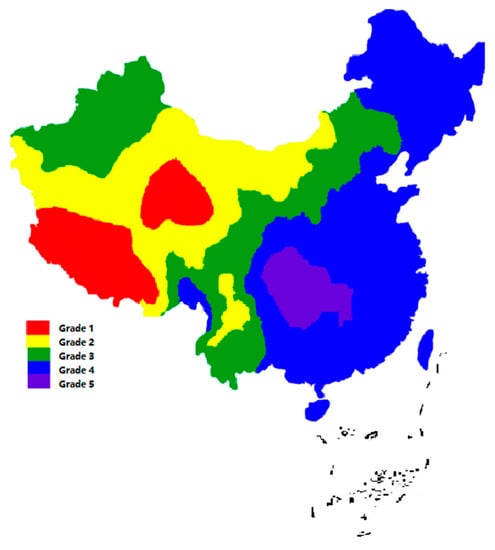
Figure 1.
Map of China showing five grades of solar radiation resource.
A map of China showing the levels of economic development is shown in Figure 2. As shown in Table 1, the annual GDP of the highest economic level (Grade 1) is higher than 50,000 RMB per capita, while the annual GDP of the lowest economic level is 10,000–20,000 RMB per capita. The economic development level influences the willingness of the building owners to invest solar utilization systems on building roofs.
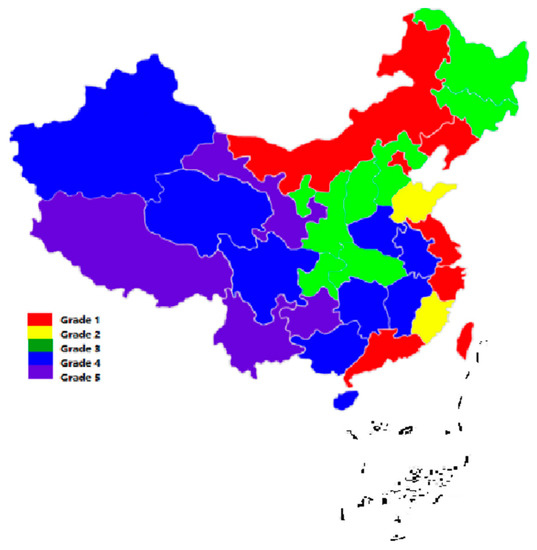
Figure 2.
Map of China showing different economic development levels.
According to the average temperatures of the hottest month and the coldest month, the division of thermal climate zones in China is presented in Figure 3. A definition of the five climate zones is given in Table 1. The climate zone of the Grade 1 is characterized with a hot summer and a warm winter, while the climate zone of Grade 5 is characterized with an extreme cold winter. The thermal climate zone has a significant influence on the thermal conditions of buildings: for example, insulation and the energy use of the buildings.

Figure 3.
Map of China showing different climate zones for building thermal design.
Considering various influential factors, all provinces and cities in China are divided into 13 zones; see Figure 4.
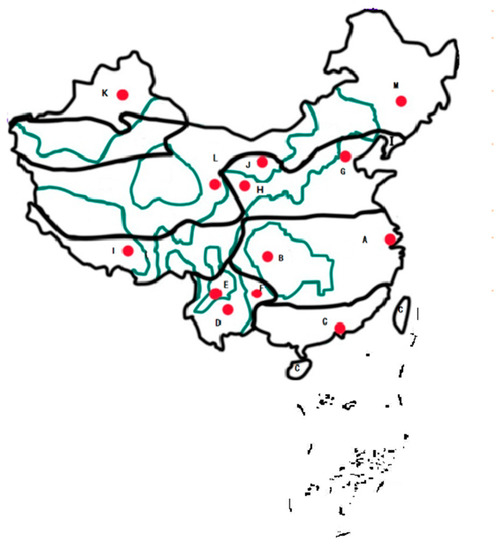
Figure 4.
Zones chosen.
A division of 13 zones gives a good foundation for the evaluation of regional adaptability of different solar utilization technologies. Then, a typical city is identified for each zone, as shown in Table 2.

Table 2.
Typical cities of 13 zones chosen.
2.2. Selection of Typical Buildings
For each of the 13 zones, a typical building is then determined. The shapes and the functions of the buildings influence their energy consumption and the available roof areas.
Different shapes of buildings have different heights and ground floor areas. Firstly, the available roof area for solar utilization systems is dependent on the building height. In other words, for a fixed roof area, the higher the building is, the larger the energy consumption of the building and the less the contribution of the roof to the entire building will be. It should be clarified that the facades of the buildings could also be utilized by solar PV systems. In densely populated urban cities, there will be significant shading on the facade-mounted systems by neighboring buildings. The shading effect is complicated to consider, since it depends on the distance between the buildings, the shape of the buildings, and the building heights. In order to avoid over complexity, this paper focuses only on roof areas; therefore, it gives a conservative estimation of the solar utilization potential. In Table 3, the categories of buildings by height in China are listed [35]. The low-rise buildings in China include public buildings with height lower than 24 m and residential building with less than 10 stories, while the super high-rise buildings have a height higher than 100 m.

Table 3.
Category of buildings by height.
Secondly, in the investigations, a near-rectangular building shape is assumed; therefore, the available rooftop area for the solar utilization systems is approximately the same as the ground floor area. The ground floor area, depending on the building height, will be significantly different between different buildings.
A survey of approximately 1170 modular buildings was carried out. Based on the statistics of the survey, 100 buildings were identified and analyzed. Among the 100 buildings investigated, 28 buildings are selected as typical buildings, and statistics of the length–width ratio of the buildings is conducted. The results are shown in Figure 5. It is found that 82% buildings have a length–width ratio less than 3, and 86% have a length–width ratio less than 4. Figure 5 shows the relation between the ground floor area and the length–width ratio. It is found that a building with a larger ground floor area typically has a smaller length–width ratio. When the ground floor area exceeds 3000 m2, the length–width ratio will be lower than 2.
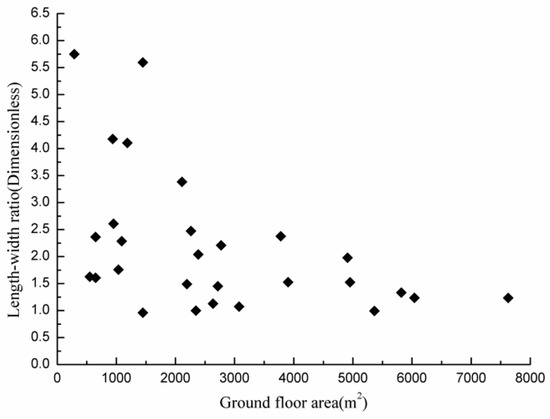
Figure 5.
The length–width ratio vs. the ground floor area for the investigated buildings.
The function of the building influences its construction and its energy consumption after commissioning. In China, there are two types of typical civil buildings, namely public buildings and residential buildings. According to the statistical result, 18 buildings with different length–width ratios, rooftop areas, and levels are selected in investigations to evaluate the energy-saving effect of different solar roof technologies. The 18 typical buildings are listed in Table 4.

Table 4.
Typical buildings.
In the investigated buildings, there are 4 residential buildings with 2–24 stories and a ground floor/rooftop area from 200 to 1440 m2. The length to width ratio ranges from 1 to 4. The six official buildings have a rooftop area from 1000 to 4000 m2, ranging from multi-story buildings (4 levels) to high-rise buildings (28 levels). Two length to width ratios (1 and 4) were investigated. The investigated buildings also include 4 commercial buildings (supermarket, shopping centers) and 4 hotel buildings. They are selected due to their special energy demand patterns. For example, the hotel buildings have a larger domestic hot water demand, while the commercial buildings have a different energy demand pattern as residential buildings. The selected buildings should give a good representation of the existing buildings in China.
2.3. Parameters of the Buildings
In order to calculate the thermal performance of the typical buildings, the typical U values of the building envelop should be used. Table 5 shows heat loss coefficients of the building envelope in different climate zones, according to the relevant guidelines, standards, or codes in China [36,37,38,39,40]. The typical U values represent the thermal insulation properties of the buildings constructed in China from 2003.

Table 5.
Typical U values of the building envelope.
The internal heat loads of the buildings are also considered in the investigations, inclusive heat loads due to lighting, occupant, equipment, and air exchange. The parameters of heat loads are listed in Table 6 for different building types, according to the national guideline.

Table 6.
Parameters of heat loads for different building types.
Relative indoor air humidity is controlled between 30% and 60%, and the COP of the heat pump system is 2.5 for cooling and 3.5 for heating. The hourly occupancy rate and on/off schedule of lighting, equipment and air conditioners are strictly set according to the operation time of the buildings. The operation time and designed indoor temperatures for an office building and a commercial building are listed in Table 7.

Table 7.
Operation time and design indoor temperatures of the buildings.
With the aforementioned parameters as inputs, the thermal performance of all the investigated buildings can be calculated using EnergyPlus, and the energy consumption will be analyzed.
2.4. The Solar Utilization Systems
There are two relevant solar utilization technologies for the building rooftops: solar heating and solar PV. The solar heating system can be used to provide domestic hot water services and space heating, while the solar PV system can be used to provide electricity.
2.4.1. The Solar Heating System
For multi-story buildings in urban cities, due to the limitation of available solar energy on rooftops, the solar heating system is typically used to provide domestic hot water. Therefore, the solar heating system is designed to cover the demand of hot water of the building. Determining the solar collector area is the important step to analyze the adaptability of solar thermal technology on a building roof.
In the relevant code on hot water supply [41], daily hot water usage per capita is given depending on the function of the building. For example, the hot water temperature is typically 60 °C. The maximum daily hot water consumption is about 60–100 L per capita for a residential building equipped with a central hot water supply system. The hot water consumption is quite different for an office building. Based on the daily hot water consumption per capita and the number of occupants, the total hot water consumption and the heat needed can be calculated, and then, the gross area of the solar collectors can be obtained [42]:
Ac = Lw c ρ (th − tc) f/[Jt ηc (1 − ηl)]
In the equation, Ac is the solar collector area, m2; Lw is the total hot water usage, L; th is the temperature of hot water, °C; tc is the mains water temperature, °C; c is the specific heat of water, kJ/(kg °C); ρ is the density of water, kg/L; f is the solar fraction,%; Jt is the annual average solar radiation, W/m2; ηc is the average solar collector efficiency, %; ηl is the loss of efficiency due to the heat loss of pipes and tanks, %.
Based on Equation (1), the solar faction f could be calculated. The maximum solar collector area is proportional to the rooftop area depending on row distance, collector tilt, and the location of the buildings, therefore, the maximum solar fraction could be determined.
2.4.2. The Solar PV System
The solar PV system mounted on the building roof is used to produce electricity, which can be used to cover the demand of the building or can be fed into the electrical grid. The application of solar PV technology is also influenced by its location, available solar radiation resource, the roof area, and the length–width ratio. Electricity may be stored or directly fed into the grid; thus, it is not influenced by the function of buildings. In general, the power generation of a solar PV system is proportion to the available solar radiation on the PV panel. In addition, the location of the building will influence the inclination, spacing, and area of PV panels. The total PV power generation can be roughly estimated by the following equation:
In the equation, EPV is the energy generated, kWh; Jt is the annual average solar radiation, kJ/m2; ηPV is the efficiency of the PV panel, %; and APV is the PV panel area, m2.
In this study, according to the relevant code on the PV power station [43], the solar power generation was calculated using the software SAM (Solar Advisor Model). The PV modules of 166–60 c with an area of 1.8 m2 each were chosen and arranged in arrays on the available area of the roof. The PV modules face south and are tilted according to the local latitude. The minimum distance between the front and the rear rows without shading on the winter solstice was calculated. The TMY weather data are adopted to estimate the PV annual power generation. It should be pointed out that future climate change could affect solar photovoltaic power by altering climate variables, such as global horizontal irradiance, surface wind speed, and surface air temperature [44]. The impact of future climate change is not considered in the investigations.
2.5. Evaluation of the Energy-Saving Benefit
2.5.1. Evaluation of Energy-Saving for the Solar Heating System
The application of the solar thermal technology is influenced by the location of the buildings, solar radiation, roof area, the length–width ratio, and the function of the building. The optimal inclination and spacing of the solar collectors depend on the location of the building. The solar collector area is designed to cover the hot water demand of the building with a certain solar fraction in different areas.
The energy saving of the solar domestic hot water system can be estimated in Equation (3).
In the equation, ΔQ is the energy saving, kJ; Lw is the total hot water usage, L; th is the temperature of hot water, °C; tc is the mains water temperature, °C; c is the specific heat of water, kJ/(kg °C); ρ is the density of water, kg/L; and f is the solar fraction, %.
In this study, the solar heat output is also calculated using the software SAM. The relevant parameters of the solar collectors were obtained from collector test reports provided by the manufacturers.
The energy savings of the solar domestic hot water system for the 18 buildings in Beijing, Shanghai and Guangzhou are shown in Figure 6. The three cities are the most important cities with densely populated buildings; therefore, they were used in the investigations. The absolute energy savings are defined as the energy savings for domestic hot water services for the building, while the relative energy saving is defined as the ratio of the energy savings of the solar domestic hot water system and the total heat demand of the building.
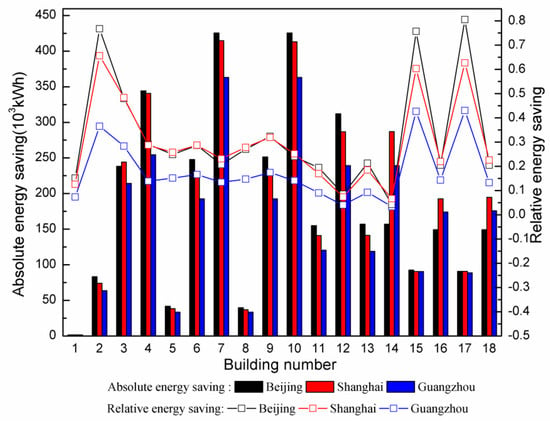
Figure 6.
Energy saving of the solar domestic hot water systems.
Figure 6 shows the energy saving of the buildings in MWh. The energy saving for hot water is lower in Guangzhou, because the hot water consumption in Guangzhou is much lower than that in Beijing and Shanghai. With an increase in stories of the building, the hot water consumption and the saved energy increase. In Figure 6, the residential buildings (building number 1–4) and the hotel buildings (15–18) have a larger fluctuations of relative energy savings, ranging from 10% to 80%. For a single-family house (Building no. 1), the relative energy saving is very low, because domestic hot water demand is much smaller than the space heating demand of the building. With an increase in the stories of the buildings, the number of occupants and the total domestic hot water demand increase proportionally. From Building no. 2 to no. 4, the ratio between the rooftop area and the total floor area decrease; therefore, the solar contribution to the domestic hot water consumption decreases from 70–75% to 30%. It is shown that the relative energy savings for Beijing and Shanghai are similar, while it is significantly lower for Guangzhou. It is most likely due to a lower hot water consumption per capita and a higher energy demand for cooling in Guangzhou where there is a hot climate. For office buildings (5–10) and commercial buildings (11–14), the relative energy savings are low, because the domestic hot water consumptions in these buildings is much smaller than those of residential and hotel buildings.
2.5.2. Evaluation of Energy-Saving Benefit for the Solar PV System
The amount of energies generated by the solar PV system are shown in Figure 7 for different building roofs in different zones.
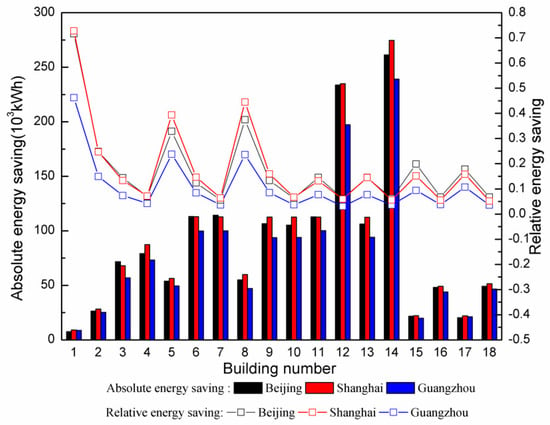
Figure 7.
Energy saving by the solar PV technology.
Figure 7 shows that the main factor influencing the energy saving of a PV system is the roof area of the building. With a larger roof area, more power is produced. Since building 12 and 14 have a larger roof area, the energy saving of buildings 12 and 14 are 180–225 MWh and 225–275 MWh, respectively, which are the top 2 largest energy saving. The relative energy savings of a single-family house (72% for Beijing and Shanghai and 50% for Guangzhou) are the largest among the 18 buildings. That could be explained by a relative larger roof to floor area ratio for a single-family house. For the office buildings (5–10), there is a strong correlation between the relative energy saving and the story of the building. The energy-saving percentage decreases significantly with an increase in the building height from 4 to 28 floors. For the commercial buildings, although the energy saving in MWh increases significantly with an increase in the roof area from 2000 to 4000 m2, the energy-saving percentage remains lower than 15%.
2.6. Evaluation of the Environmental Benefit
As the majority of the electricity in China is generated by thermal power plants burning coal, a reduction in the electricity consumption means a reduction in pollutant emissions such as carbon dioxide, sulfide, and dust. The environmental benefit of the solar roof is huge.
The environmental benefit of the two roof utilization technologies is evaluated based on emission reduction in carbon dioxide.
CO2 emission reduction per year is determined by the following equation [32]:
where GCO2 is the CO2 emission reduction per year, t; Ef is the efficiency of the heater, %; Qsc is the calorific value of standard coal, 29.308 MJ/kg; FCO2 is the carbon emission factor, 0.866 is chosen for electricity; and 44 and 12 are, respectively, the molecular weight of carbon dioxide and carbon.
For every kilowatt hour of electricity saved, the emission of carbon dioxide will decrease by about 0.85 kg. Therefore, the reduction in carbon dioxide emission by different technologies can be obtained for different building types and different cities. Since most cities of China have a rich solar radiation resource, the reduction in CO2 emission is considerable. Figure 8 shows the reductions of CO2 emission for different solar utilization technologies. Apparently, the emission reduction in a solar domestic hot water system is in general larger than that of a solar PV system due to the fact that the solar to heat conversion efficiency is typically 40–60%, which is 2–3 times higher than the solar to electricity conversion efficiency (15–20%).
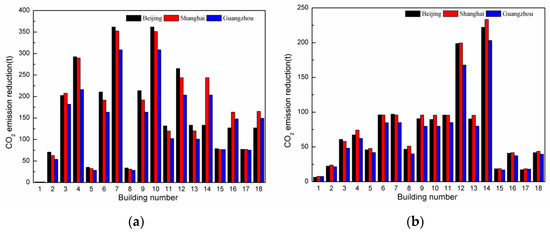
Figure 8.
CO2 emission reduction by the solar energy technologies. (a) Solar thermal. (b) Solar PV.
2.7. Evaluation of the Economic Benefit
The economic benefit is obtained by economic analysis of a specific technology, which considers the investment cost and operation and maintenance cost of such technology, together with governmental subsidy and the cost saving due to energy saving. Once the investment payback period is calculated, the economic gain of different technologies will be determined for different buildings and different cities. The work flow of the economic analysis is shown in Figure 9. The annual income is calculated based on the calculated energy savings of the systems.
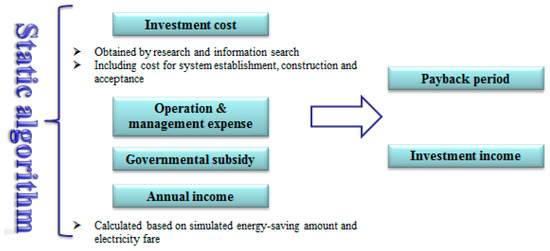
Figure 9.
Work flow of the economic analysis.
Table 8 shows the investment cost, the operation or management expense, and the governmental subsidy for the two solar technologies. The data are determined based on the national guidelines and recommendations from the leading manufacturers.

Table 8.
Cost and subsidy of the solar utilization technologies.
With PVs being more efficient and cost-effective, the operation and maintenance (O&M) cost of PVs might gradually decrease in the coming years. However, it is difficult to foresee and quantify the O&M cost of PVs in the future; therefore, the decrease in O&M cost due to technology improvement is not considered in the economic prediction. This limitation of the study means that the analysis is conservative and might underestimate the potential of PV technologies.
Based on the work flow shown in Figure 9, the payback period of roof utilization technologies is calculated. The typical payback periods are listed in Table 9.

Table 9.
Payback period of the two technologies.
The average payback time of a solar PV system for all the investigated buildings is 12 years, while the payback time decreases to 4.5 years if a flat plate solar collector is used to provide domestic hot water service. However, the payback time for a PV system could be as lower as 5 years and as high as 26. The longer investment payback period is seen for Chongqing and Xingyi city because of poor solar radiation resource. Since the lifetime of the solar thermal system is about 10–15 years, most systems can be paid back. Solar PV technology has a longer investment payback period (on average 12 years), but it is still within the lifetime of a PV system.
2.8. Adaptability Index Evaluation
The energy saving, CO2 emission reduction, and economic benefit of 18 typical buildings in 13 zones are analyzed, respectively. The three benefits are classified into five grades from 1 to 5, with 1 for the worst and 5 for the best. Then, an adaptability index is determined by the weighted average of the three benefits. A questionnaire survey was conducted for the relevant manufacturers and users; 400 copies of the questionnaire were distributed, while 300 valid copies were received. The questionnaire covers questions concerning safety issues, service life, cost, impact on buildings, and prioritization. The aim of the questionnaire was to determine the weighting ratios of the environment benefit, the energy-saving benefit, and the economic benefit. The survey shows that the three benefits are considered more or less equally important; therefore, an equal weighting factor is used in the calculations.
2.8.1. Adaptability Index for the Solar Thermal Technology
The adaptability index of the solar thermal technology is shown in Figure 10.
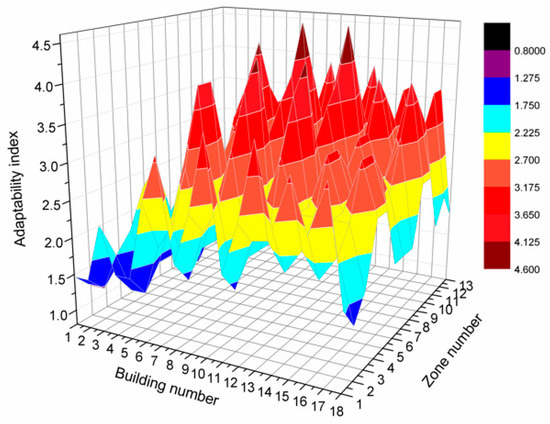
Figure 10.
Adaptability index of the solar thermal technology.
The solar thermal technology has a larger fluctuation of the adaptability index. The upper limit of the index is 4.62 (Building No. 10 and No. 13 in Zone 9, Lhasa), while the lower limit is 1.23 (Building No. 1 and No. 2 in Zone 6 Xingyi). The standard deviation is 0.81.
The index is higher in Zone no. 4 (Kunming), Zone no. 8 (Lanzhou), Zone no. 9 (Lhasa), Zone no. 10 (Yinchuan), and Zone no. 12 (Xining). These areas are located in the northwestern part of China where there are abundant solar energy resources. While for zone no. 1 (Shanghai), 2 (Chongqing), and 3 (Guangzhou), the solar energy resource is relative poorer, resulting in a lower adaptability index. These findings indicate that a better policy and/or a stronger government subsidy are necessary to promote the use of solar heating systems in these regions with a relatively lower solar energy resource.
2.8.2. The Adaptability Index Evaluation for a Solar PV System
The adaptability index of the solar PV system is shown in Figure 11.
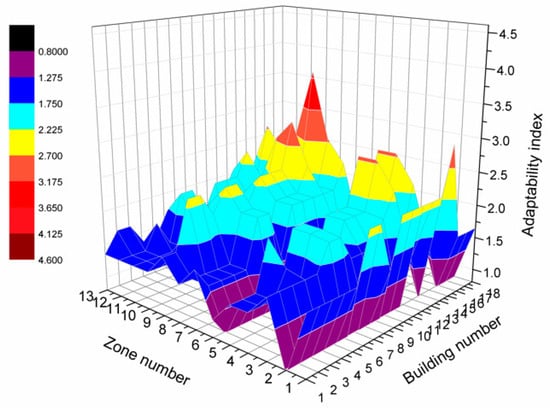
Figure 11.
Adaptability index of the solar PV technology.
The solar PV technology experiences smaller fluctuations in adaptability index. The upper limit of the index is 3.75 (Building No. 14 Zone 9 Lhasa), and the lower limit is 0.75 (residential buildings in Zone 2, Chongqing). The standard deviation is 0.54. Similar to findings on solar heating systems, the solar PV system has a higher adaptability in these areas with rich solar energy.
Figure 12 shows the difference between the adaptability index of the solar heating system and the index of the solar PV system. A positive value means that the solar heating system has a higher adaptability index than the solar PV system and vice versa. For the low-rise residential buildings with a smaller roof area (Buildings no. 1 and 2), the solar PV system gives more benefit than the solar heating systems in Zone no. 1 Shanghai and no. 3 Guangzhou, since the solar contribution of a PV system reaches as high as 70%. For the 12-story Building no. 3, solar heating is more preferred than the solar PV system. For the office buildings, the solar heating system gives a higher index than the solar PV system for almost all regions of China. The same is true for hotel buildings. For commercial buildings, the solar PV system is more beneficial for the 10-story building with a ground floor area of 4000 m2 (no. 14).
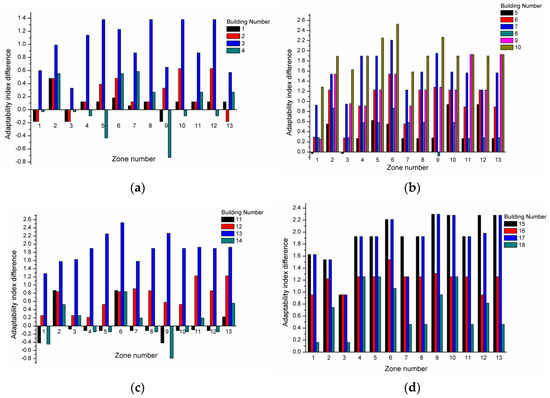
Figure 12.
Adaptability index difference between the solar thermal technology and the PV technology. (a) Residential buildings. (b) Office buildings. (c) Commercial buildings. (d) Hotel building.
In general, the adaptability of a solar heating system is higher than that of a solar PV system, and the average adaptability index is 2.54 and 1.63 for the solar heating and solar PV system, respectively. The average adaptability index of the solar utilization technologies in each zone is shown in Table 10.

Table 10.
Average adaptability index of solar technologies in different zones.
3. Case Analysis
3.1. Basic Information of the Case
A case analysis of an office building was carried out to verify the findings of the paper. The office building in Beijing is a slab-type building. It includes eight floors, with each floor measuring a height of 3 m. The roof area is 88 m × 22 m and the shape coefficient is 0.11. These buildings are in service from 8:00 a.m. to 19:00 p.m., with high load in occupants, lighting, and equipment.
Beijing in cold zone is classified into Grade 4 in terms of solar energy resources.
Beijing provides policy support for the roof utilization technologies and encourages roof utilization. A certain subsidy is available for solar PV technology.
3.2. Adaptability Analysis
Since the eight-floor office building is the closest to Building no. 8 and Building no. 9, these two building types are used in the comparison. The results are shown in Table 11. It is shown that solar thermal technology is more preferred for the office building than solar PV technology.

Table 11.
Adaptability index of the test case.
3.3. Simulation Verification
Based on the investment cost, operation and maintenance fee, service life, and policy-related subsidy, the payback period of the solar thermal technology and the solar PV technology is calculated to be 3.26 years and 10.1 years, respectively. The accuracy of the adaptability evaluation methods is analyzed and verified with the simulation software. The results of the simulation is shown in Table 12. By taking all three benefits into consideration, the solar thermal technology is more preferred than solar PV for the office building in Beijing.

Table 12.
The results of the test case based on software simulations.
4. Conclusions
This paper developed a new evaluation method for solar roof utilization technologies, considering the various influential factors, inclusive solar radiation, thermal climate division, and economic development level. Eighteen typical buildings from 13 different climate zones were evaluated using the proposed method. For utilization of the building rooftop, the following findings are obtained:
- (1)
- The average adaptability index values for solar thermal technology and solar PV technology are 2.54 and 1.63, respectively. Solar thermal technology has a shorter nominal investment payback period; therefore, it is more preferred in most of the investigated scenarios, especially in residential buildings and hotel buildings with a hot water demand.
- (2)
- The average payback time of a solar PV system for all the investigated buildings is 12 years. The payback time for a PV system could be as low as 5 years and as high as 26. The longer investment payback period is seen for Chongqing and Xingyi city because of poor solar radiation resource.
- (3)
- Technical specifications or application standards regarding roof utilization in China should be launched by relevant national departments to guide and regulate the reasonable use of building roofs. It is considered essential to promote the development of roof utilization technologies. Provincial or municipal governments should develop five-year or ten-year development plans for roof utilizations considering local economic development, climate conditions, solar resources, energy conservation and emission reduction, urban sustainable development, and urban ecological environment, as well as the function of buildings and adaptability of roof utilization technologies.
- (4)
- Since a larger difference may exist between the simulation and the practical application, it is recommended to carry out further detailed investigations in order to develop a sophisticated database of adaptability of roof utilization technologies for references in the future engineering practice.
Author Contributions
Conceptualization, J.H. and J.F.; methodology, J.F.; software, Q.L.; validation, J.H.; investigation, J.H.; data curation, Q.L.; writing—original draft preparation, J.H. and Q.L.; writing—review and editing, J.F. All authors have read and agreed to the published version of the manuscript.
Funding
This research was funded by Shandong Provincial Natural Science Foundation, grant number ZR2021ME051 and the National Natural Science Foundation of China grant number 51608290.
Institutional Review Board Statement
Not applicable.
Informed Consent Statement
Not applicable.
Data Availability Statement
Available upon request.
Conflicts of Interest
The authors declare no conflict of interest.
References
- China National Bureau of Statistics. China Statistical Yearbook 2019; National Bureau of Statistics of the People′s Republic of China: Beijing, China, 2019. (In Chinese)
- Jeppesen, B. Rooftop solar power: The solar energy potential of commercial building rooftops in the USA. Refocus 2004, 5, 32–34. [Google Scholar] [CrossRef]
- Wong, N.H.; Chen, Y.; Ong, C.L.; Sia, A. Investigation of thermal benefits of rooftop garden in the tropical environment. Build. Environ. 2003, 38, 261–270. [Google Scholar] [CrossRef]
- Huide, F.; Xuxin, Z.; Lei, M.; Tao, Z.; Qixing, W.; Hongyuan, S. A comparative study on three types of solar utilization technologies for buildings: Photovoltaic, solar thermal and hybrid photovoltaic/thermal systems. Energy Convers. Manag. 2017, 140, 1–13. [Google Scholar] [CrossRef]
- Niko, L.; Danijel, Ž.; Sebastijan, S.; Borut, Ž.; Gorazd, Š. Rating of roofs’ surfaces regarding their solar potential and suitability for PV systems, based on LiDAR data. Appl. Energy 2013, 102, 803–812. [Google Scholar]
- Kodysh, J.B.; Omitaomu, O.A.; Bhaduri, B.L.; Neish, B.S. Methodology for estimating solar potential on multiple building rooftops for photovoltaic systems. Sustain. Cities Soc. 2013, 8, 31–41. [Google Scholar] [CrossRef]
- Gergelova, M.B.; Kuzevicova, Z.; Labant, S.; Kuzevic, S.; Mizak, J. Roof’s Potential and Suitability for PV Systems Based on LiDAR: A Case Study of Komárno, Slovakia. Sustainability 2020, 12, 10018. [Google Scholar] [CrossRef]
- Karteris, M.; Slini, T.; Papadopoulos, A.M. Urban solar energy potential in Greece: A statistical calculation model of suitable built roof areas for photovoltaics. Energy Build. 2013, 62, 459–468. [Google Scholar] [CrossRef]
- Redweik, P.; Catita, C.; Brito, M. Solar energy potential on roofs and facades in an urban landscape. Sol. Energy 2013, 97, 332–341. [Google Scholar] [CrossRef]
- Ordóñez, J.; Jadraque, E.; Alegre, J.; Martínez, G. Analysis of the photovoltaic solar energy capacity of residential rooftops in Andalusia (Spain). Renew. Sustain. Energy Rev. 2010, 14, 2122–2130. [Google Scholar] [CrossRef]
- Izquierdo, S.; Montanes, C.; Dopazo, C.; Fueyo, N. Roof-top solar energy potential under performance-based building energy codes: The case of Spain. Sol. Energy 2011, 85, 208–213. [Google Scholar] [CrossRef]
- Jo, J.H.; Otanicar, T.P. A hierarchical methodology for the mesoscale assessment of building integrated roof solar energy systems. Renew. Energy 2011, 36, 2992–3000. [Google Scholar] [CrossRef]
- Kabir, M.H.; Endlicher, W.; Jägermeyr, J. Calculation of bright roof-tops for solar PV applications in Dhaka Megacity, Bangladesh. Renew. Energy 2010, 35, 1760–1764. [Google Scholar] [CrossRef]
- Koo, C.; Hong, T.; Park, H.S.; Yun, G. Framework for the analysis of the potential of the rooftop photovoltaic system to achieve the net-zero energy solar buildings. Prog. Photovolt. Res. Appl. 2014, 22, 462–478. [Google Scholar] [CrossRef]
- Li, Z.H.; Zhang, W.; He, B.; Xie, L.Z.; Chen, M.; Li, J.H.; Zhao, O.F.; Wu, X. A Comprehensive Life Cycle Assessment Study of Innovative Bifacial Photovoltaic Applied on Building. Energy 2022, 245, 123212. [Google Scholar] [CrossRef]
- Shafique, M.; Luo, X.W.; Zuo, J. Photovoltaic-green roofs: A review of benefits, limitations, and trends. Sol. Energy 2020, 202, 485–497. [Google Scholar] [CrossRef]
- Shafique, M.; Xue, X.L.; Luo, X.W. An overview of carbon sequestration of green roofs in urban areas. Urban For. Urban Green. 2020, 47, 126515. [Google Scholar] [CrossRef]
- Pokhrel, S.; Amiri, L.; Poncet, S.; Sasmito, A.P.; Ghoreishi-Madiseh, S.A. Renewable Heating Solutions for Buildings; a Techno-economic Comparative Study of Sewage Heat Recovery and Solar Borehole Thermal Energy Storage System. Energy Build. 2022, 259, 111892. [Google Scholar] [CrossRef]
- Feng, H.; Wang, G.; Li, Q.Y.; Zhang, Y.X.; Li, H.Y. Investigation of a Solar Heating System Assisted by Coupling with Electromagnetic Heating Unit and Phase Change Energy Storage Tank: Towards Sustainable Rural Buildings in Northern China. Sustain. Cities Soc. 2021, 21, 103449. [Google Scholar] [CrossRef]
- Han, X.; Garrison, J.; Hug, G. Techno-economic Analysis of PV-battery Systems in Switzerland. Renew. Sustain. Energy Rev. 2022, 158, 112028. [Google Scholar] [CrossRef]
- Aghamolaei, R.; Shamsi, M.H.; O’Donnell, J. Feasibility Analysis of Community-Based PV systems for Residential Districts: A Comparison of On-site Centralized and Distributed PV Installations. Renew. Energy 2020, 157, 793–808. [Google Scholar] [CrossRef]
- Duman, A.C.; Güler, O. Economic Analysis of Grid-connected Residential Rooftop PV Systems in Turkey. Renew. Energy 2020, 148, 697–711. [Google Scholar] [CrossRef]
- Montan’e MRuiz-Valero, L.; Labra, C.; Faxas-Guzmán, J.G.; Girard, A. Comparative Energy Consumption and PhotoVoltaic Economic Analysis for Residential Buildings in Santiago de chile and Santo domingo of the Dominican Republic. Renew. Sustain. Energy Rev. 2021, 146, 111175. [Google Scholar]
- Qiu, S.; Wang, K.; Lin, B.; Lin, P. Economic Analysis of Residential Solar Photovoltaic Systems in China. J. Clean Prod. 2021, 282, 125297. [Google Scholar] [CrossRef]
- Agathokleous, R.A.; Kalogirou, S.A. PV Roofs as the First Step towards 100% RES Electricity Production for Mediterranean islands: The Case of Cypru. Smart Energy 2021, 4, 100053. [Google Scholar] [CrossRef]
- Sewchurran, S.; Davidson, I.E. Technical and Financial Analysis of Large-scale Solar-PV in eThekwini Municipality: Residential, Business and Bulk Customers. Energy Rep. 2021, 7, 4961–4976. [Google Scholar] [CrossRef]
- Lara, E.G.; García, F.S. Review on Viability and Implementation of Residential PV-battery Systems: Considering the case of Dominican Republic. Energy Rep. 2021, 7, 8868–8899. [Google Scholar] [CrossRef]
- Jin, H.; Yu, J. System Contributions of Residential Battery Systems: New Perspectives on PV Self-consumption. Energy Econ. 2021, 96, 105151. [Google Scholar]
- Lukanov, B.R.; Krieger, E.M. Distributed solar and environmental justice: Exploring the demographic and socio-economic trends of residential PV adoption in California. Energy Policy 2019, 134, 110935. [Google Scholar] [CrossRef]
- Secretariat of China Photovoltaic Industry Association. Report on the Development of Solar Thermal Utilization Industry in China 2018; China Photovoltaic Industry Association: Beijing, China, 2018. (In Chinese) [Google Scholar]
- Secretariat of China Photovoltaic Industry Association. Annual Report of China’s Photovoltaic Industry 2017–2018; China Photovoltaic Industry Association: Beijing, China, 2018. [Google Scholar]
- Liu, Y.F.; Wang, Y.; Wang, D.J.; Jiang, C.; Liu, J.P. Study on comprehensive energy-saving of shading and photovoltaic performance of roof added PV module. Acta Enegiae Sol. Sin. 2019, 40, 1545–1552. (In Chinese) [Google Scholar]
- Zhang, J.T.; Li, C.L.; Yang, L.B.; Guo, S.F. Based on GIS automation, the refined evaluation technology of solar energy and wind energy resources on the roof of regional buildings. Manuf. Autom. 2020, 42, 146–149, 156. (In Chinese) [Google Scholar]
- Wu, P.; Wang, Z.C.; Yang, Y.X.; Xu, Z.W.; Yang, Q.; Liu, F. Application research on air-source heat pump with solar roof in residential buildings in Yangtze River basin. Heat. Vent. Air Cond. 2020, 50, 10–13. (In Chinese) [Google Scholar]
- Ministry of Housing and Urban-Rural Development of the People’s Republic of China (MOHURD). GB 50352-2005 Code for Design of Civil Buildings; China Architecture and Building Press: Beijing, China, 2005. (In Chinese)
- Ministry of Housing and Urban-Rural Development of the People’s Republic of China (MOHURD). GB50189-2015 Design Standard for Energy Efficiency of Public Buildings; Ministry of Housing and Urban-Rural Development of the People’s Republic of China: Beijing, China, 2015. (In Chinese)
- Ministry of Housing and Urban-Rural Development of the People’s Republic of China (MOHURD). JGJ26-2010 Design Standard for Energy Efficiency of Residential Buildings in Frigid Zone and Cold Zone; China Architecture and Building Press: Beijing, China, 2010. (In Chinese)
- Ministry of Housing and Urban-Rural Development of the People’s Republic of China (MOHURD). JGJ134-2010 Design Standard for Energy Efficiency of Residential Buildings in Hot-Summer-and-Cold-Winter Zone; China Architecture and Building Press: Beijing, China, 2010. (In Chinese)
- Ministry of Housing and Urban-Rural Development of the People’s Republic of China (MOHURD). JGJ75-2003 Design Standard for Energy Efficiency of Residential Buildings in Hot-Summer-and-Warm-Winter Zone; China Architecture and Building Press: Beijing, China, 2003. (In Chinese)
- Ministry of Housing and Urban-Rural Development of the People’s Republic of China (MOHURD). GB 50364-2018 Technical Specification of Solar Heat Water System in Civil Buildings; China Architecture and Building Press: Beijing, China, 2018. (In Chinese)
- Ministry of Housing and Urban-Rural Development of the People’s Republic of China (MOHURD). GB 50015-2003 Code for Design of Building Water Supply and Drainage; China Architecture and Building Press: Beijing, China, 2003. (In Chinese)
- He, Z.N.; Zhu, D.Z. Techical Handbook for Solar Heat Supply & Space Heating; Chemical Industry Press: Beijing, China, 2009. (In Chinese) [Google Scholar]
- Ministry of Housing and Urban-Rural Development of the People’s Republic of China (MOHURD). GB 50797-2012 Code for Photovoltaic Power Station; China Planning Press: Beijing, China, 2012. (In Chinese)
- Santos, A.J.L.; Lucena, A.F.P. Climate change impact on the technical-economic potential for solar photovoltaic energy in the residential sector: A case study for Brazil. Energy Clim. Chang. 2021, 2, 100062. [Google Scholar] [CrossRef]
Publisher’s Note: MDPI stays neutral with regard to jurisdictional claims in published maps and institutional affiliations. |
© 2022 by the authors. Licensee MDPI, Basel, Switzerland. This article is an open access article distributed under the terms and conditions of the Creative Commons Attribution (CC BY) license (https://creativecommons.org/licenses/by/4.0/).